Technology
Women in tech history: Hedy Lamarr — Hitler, Hollywood, and Wi-Fi 📽️
This is the sixth article in a series about amazing women in tech history. Previous entries have featured Margaret Hamilton, Grace Hopper, the ENIAC programmers, Katherine Johnson, and the women of Bletchley Park.
Today’s entry is a bit of an anomaly. We’ve covered some inspiring women in this series but most of them aren’t well-known to the general public. This is particularly true for the ENIAC programmers, who were forgotten for most of their lives; and the women of Bletchley Park, who had to keep their life-saving work secret for 30 years. Hedy Lamarr, on the other hand, was a household name in the western world. She was the highest-earning woman in Hollywood at the peak of her acting career and was often described as the most beautiful woman in the world.
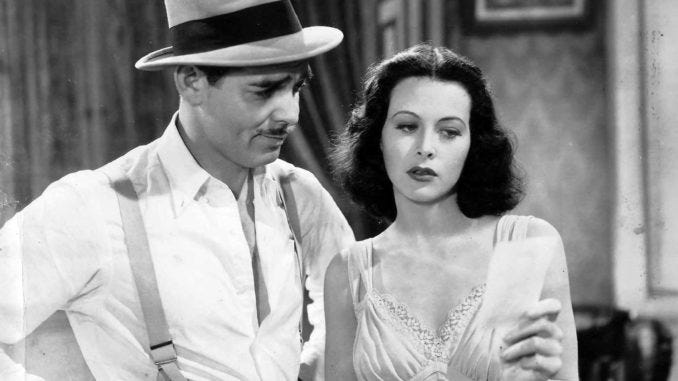
Photo: Publicity photo for Comrade X, public domain.
Lamarr got her biggest parts in movies because of her looks, which is something she regretted all her life. She became typecast for her glamour and was given few lines compared to the men she starred with. She had a creative and scientific mind and was described as someone who always came up with solutions to problems. Many people in her life didn’t actually know this about her because they made assumptions based on her appearance. Can someone be eye-candy and smart? The sexism of Hollywood drove her to be creative in other fields and she went on to invent technology that has almost certainly influenced your life.
Having Hitler for dinner
Hedy Lamarr was born Hedwig Eva Maria Kiesler in Vienna, Austria, in 1914. Lamarr began acting at a very young age and small parts in theatre productions as a child. She was eventually spotted as a teenager by German producer Max Reinhardt, who brought her to Germany to train in theatre but she soon entered the film industry. Lamarr was only 18 when she starred in Ecstasy, a controversial 1933 film where she played the ignored wife of a distant husband. This role made her famous in Austria but not necessarily for the best reasons. It was seen as controversial for showing such a young woman naked and faking orgasms.
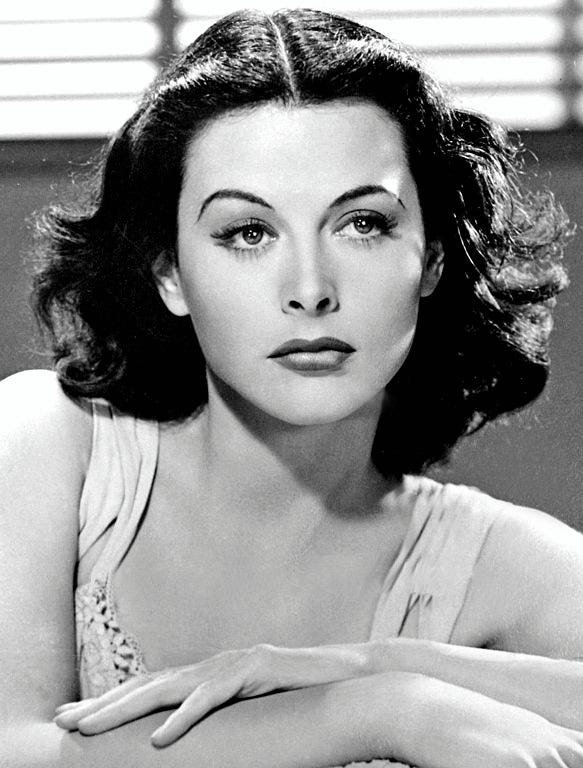
Photo: Publicity photo for Comrade X, public domain.
In 1933, the same year that Ecstasy had brought her so much attention, Lamarr married one of the richest men in Austria: Friedrich Mandl, a munitions manufacturer and merchant. Although half-Jewish, he supplied weapons to Mussolini and had close connections with the Nazis. Together they lived in a huge castle and held parties there with the likes of Mussolini and Hitler. Even by the age of 18 her life was far from ordinary.
According to Lamarr, Mandl was a jealous, controlling man and didn’t want her to continue acting for fear she would star in something like Ecstasy again. She was kept in the castle and described feeling like a prisoner. Most of her social interaction was with fascists as she was forced to accompany Mandl to his business meetings. This was a difficult time for Lamarr but there was a positive to take from it all. Many of the meetings were with military scientists discussing advanced technologies and it fascinated her. This was when she began to focus some of her time and resources in science and apply her natural creativity to fix real problems.
The escape
In 1937 Lamarr couldn’t live in that castle any longer but was sure Mandl wouldn’t allow her to leave. According to her autobiography, she disguised herself as a maid and sneaked out. She didn’t just want out of the castle, she wanted to be as far away as possible. She made her way to Paris where she met MGM head Louis B. Mayer, who was scouting for foreign talent. He convinced her to come with him to America to star in Hollywood films.
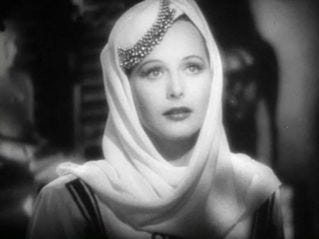
Photo: Hedy Lamarr in Lady of the Tropics. Trailer screenshot, public domain.
From 1938 to the late 1950s Lamarr dominated Hollywood. Much to her displeasure in later life, she wasn’t necessarily loved for her acting abilities or personality but for her looks alone. She was seen by many as the world’s most beautiful woman and the marketing directors recognised this so they played into it. Her foreign accent and mysterious stage name only added to the image that made her the pin-up of choice for many soldiers fighting abroad.
Lamarr seemed to have it all. She was rich, famous, and admired. But in many ways she was still a prisoner. Much like she felt trapped by Mandl and his castle, Hollywood trapped her because of her looks. She was increasingly given roles that were highly sexual with very few spoken lines. She became typecast in such a way that she appeared to many as a face rather than a person. She obviously knew there was more to her than eye-candy and this attitude sometimes caused problems with executives.
I was the highest-priced and most important star in Hollywood, but I was “difficult.”
She grew bored and needed another outlet for her creativity. With World War II on everyone’s mind and exciting technological advances happening at the same time, her interest in science was stronger than ever. She wasn’t given the freedom to invent anything on screen so she took to inventing things in the real world.
Frequency-hopping
Lamarr spent years working on inventions, many of which were successful in the fact that they worked but didn’t necessarily go anywhere commercially. These includes improved traffic lights, improved tissue boxes, and even a pill that turned water into a carbonated beverage. She had been interested in torpedoes and radio technologies since her time in Mandl’s castle, hearing scientists talk about the weapons on Nazi U-boats. During World War II, she turned her attention to inventions that could help in the fight.
She knew from those meetings that remote controlled torpedoes weren’t a good option because radio-jamming could protect Nazi boats. As long as you knew the frequency, you could disrupt the signal to the torpedo. She puzzled over ways to protect torpedoes and hit upon a solution when she met the film composer George Antheil. He used strange instruments and arrangements in his music and liked to tinker and invent much as Lamarr did. She was inspired by his use of multiple pianos roles to move music from one piano to another without missing a beat.
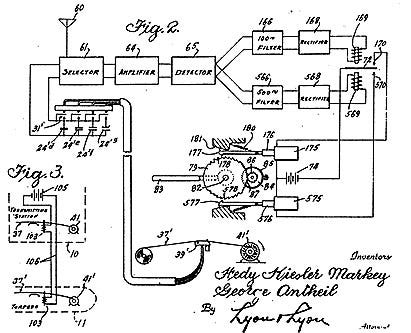
Image: A figure from the 1942 patent. Via Flickr/Floor, distributed under a CC BY-SA 2.0 license.
Together, they successful patented a genius technology, frequency-hopping spread spectrum (FHSS), which would use the piano roll to protect radiowaves from being jammed. Just as the music could transfer from one piano to another by carefully synchronising the piano rolls, radio signals could be switched to other channels using the same method. By doing these switches in a pseudorandom order known only by the transmitter and receiver, it would be impossible for the Nazis to jam or read the signal. At best they could jam one frequency but the torpedo would only be out of communications briefly until the next frequency hop.
The patent was made on 11 August, 1942, but the Navy turned it down. They didn’t fully appreciate its value, the technology would be difficult to implement, and they were reluctant to use patents that didn’t come from within the military. In the 1950s the technology was taken by engineers at Sylvania Electronics Systems Division for in military communications and by the 1960s an upgraded version was indeed being used to control torpedoes.
It’s all around us
Frequency-hopping spread spectrum is one of the most important aspects of Code division multiple access (CDMA), which is in many technologies we use today. One of its first is in GPS, which you use every time you check your location in your smartphone’s maps app. Mobile phones also used CDMA for phone signals and if you’ve ever downloaded something over a 3G network you were using technology built around Lamarr and Antheil’s invention. With frequency-hopping spread spectrum technology being all around us, it’s easy to take it for granted, but the invention should be admired and respected for being so creative and ingenious.
Despite the work influencing so much technology that dominates our lives, they never received much recognition for the work. Lamarr didn’t receive any money for the use of her patent by the Navy or by phone companies. Like many of the women in tech history we’ve written about, Lamarr was largely ignored for most of her life when it came to science and technology. Now there are a few books about her life and movements to get her recognised. The latest project was a documentary about her life to be filmed by Reframed Pictures. Here’s Susan Sarandon talking about the project:
People started to make the connection between the Hollywood superstar and frequency-hopping in the 1990s. In 1997 she finally received recognition for her work when the the Electronic Frontier Foundation gave her the Pioneer Award. According to her biographer Richard Rhodes:
When they called her up to tell her she would get the award her first words were, Hedy Lamarr being Hedy Lamarr, “Well, it’s about time.”
Lamarr was in her 80s when she received this recognition then died shortly after of heart failure in 2000. In 2014 both co-inventors of the technology were inducted into the US National Inventors Hall of Fame.
Scared money
Lamarr didn’t think she was necessarily smarter than people around her. Instead, it was her attitude that set her apart. She asked questions. She wanted to improve things. She saw problems and knew they didn’t have to be problems. Some people in her life saw it as the wrong attitude and she was often criticised for being a difficult star. But Lamarr was doing exactly what she wanted to do so was clearly winning. And how did she win? As she said in Popcorn in Paradise:
I win because I learned years ago that scared money always loses. I never care, so I win.
“Scared money” refers to being so afraid of losing that it impairs your decision-making and makes it more likely that you will lose. Lamarr was able to let that go. She had the world’s eyes on her just waiting for a mistake yet she made it in Hollywood and when that didn’t appeal anymore she contributed to technology you’re likely using while reading this. She was beautiful, smart and talented but none of that guaranteed success in male-dominated fields. What mattered most was that she wasn’t afraid.
Lamarr faced sexism like all the women in this series but in arguably more unusual circumstances. She wasn’t just a woman in tech; she was also a superstar admired for her beauty. According to Lamarr, this meant she faced two very different sides of misogyny. Some people assumed, from looks alone, that she wasn’t smart. Others assumed that if she was smart then it was a negative aspect of her personality. Her smarts were likely a devious, deceptive, untrustworthy intelligence and this was a problem rarely said about attractive male leads. Sometimes you just can’t win, except she eventually did. She won because scared money always loses and she wasn’t afraid to be herself.
This is the sixth article in a series about amazing women in tech history. Previous entries have featured Margaret Hamilton, Grace Hopper, the ENIAC programmers, Katherine Johnson, and the women of Bletchley Park.
Women in tech history: Bletchley Park
This is the fifth article in a series about amazing women in tech history. Here we look at the women of Bletchley Park who saved many lives during World War II.
Women in tech history: Katherine Johnson, the mathematician who guided us to the moon 🚀
This is the fourth article in a series about amazing women in tech history. The first featured Margaret Hamilton, the software engineer who helped land us on the moon. The second featured Grace Hopper, a programming pioneer and first woman to be a US Navy Admiral. The third featured the ENIAC programmers, who were pioneers ignored by history.
The women featured so far in this series have been white Americans. There are many more stories to tell and upcoming articles will feature women here in the UK and elsewhere abroad. For now we turn our attention to Katherine Johnson, an amazing woman who faced both gender and racial discrimination in pursuit of her passion. I chose to focus on Katherine in this article because I wonder how many people know that the trajectory for NASA’s first manned mission was calculated by an African American woman.
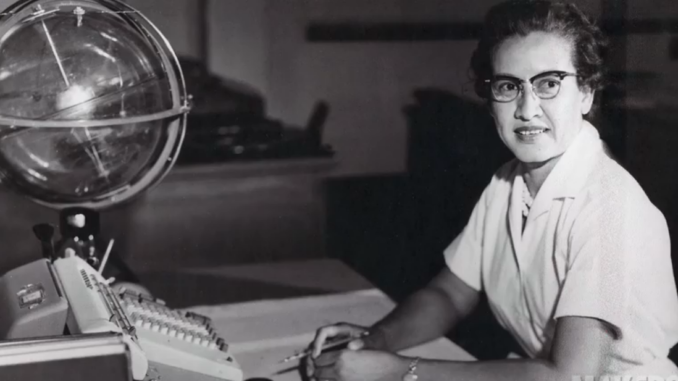
Photo: NASA
Katherine was born in August 26, 1918, which happens to be Women’s Equality Day in the US. Her family lived in West Virginia, where her father was a farmer and part-time janitor. Her mother was a teacher before having 4 children of which Katherine was the youngest. It was clear from a very young age that maths would become a huge part of Katherine’s life.
“I counted everything. I counted the steps to the road, the steps up to church, the number of dishes and silverware I washed… anything that could be counted, I did.”
Her father was desperate to get his children a decent education but had little choice at home; the local school wouldn’t teach African Americans beyond 8th grade. He had to send them to a school 125 miles away from their home. Teachers at the school were amazed at Katherine’s abilities not just with numbers but her reading skills. When she started school she skipped straight to 2nd grade and then later skipped 5th grade meaning she was a grade above some of her older siblings. This acceleration meant she started high school at the age of 10.
Towards the end of high school, Katherine was taught by Schiefflin Clayton who only the 3rd African American to earn a PhD in maths. He instantly recognised Katherine’s talents and love for astronomy. He created entire courses at the school just for Katherine, including analytic geometry, and she was usually the only pupil in these lessons. She finished high school and started college at the age of 14 and had completed a Bachelor of Science degree in maths and French by the time she was 18.
The height of segregation
Katherine wasn’t oblivious to racism growing up but hadn’t experienced the worst of it until she began working. Her first job was as a teacher but she had to travel to Virgina. Her mother warned her that things were worse there than in West Virginia and that she should be careful. Katherine responded, “Well, tell them I’m coming.”
Katherine’s story is one of personal strength. She once told NASA administrator Charles Boldon that she didn’t care too much about racism in her own life. “I didn’t have time for that… don’t have a feeling of inferiority. Never had. I’m as good as anybody, but no better.” Katherine grew up when segregation in the US was at its worst but it wasn’t something that could stop her doing what she wanted to do. She braved the segregated bus commutes and worked as a teacher for several years.
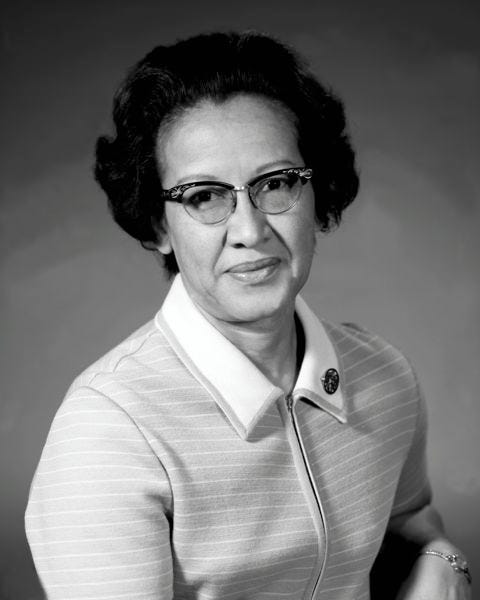
NASA
During World War II, there were shortages for scientists and engineers as many were fighting overseas. This led to the hiring of women mathematicians for important roles during the war. In 1941, Franklin D. Roosevelt signed an order to begin hiring more African Americans too. Two years later, the Langley Research Centre began hiring African American women who studied maths and chemistry to work as “human computers” in a research lab. In 1953, Katherine joined the women at Langley working for NACA, which would become NASA. Katherine didn’t escape racism by joining NASA; the employees were segregated and the reminders were always there. The lab itself was built over a former plantation.
Katherine was not alone when she joined; dozens of African American women worked at Langley as human computers, doing extremely complex calculations for a number of projects in the space race. The job paid better than many alternatives for educated women at the time ($2000 per year) but they were still discriminated against. At the research lab, the women were segregated in “coloured” work-spaces separate from the white women doing the exact same work. They were made to work a mile away from the other women and in facilities that didn’t even have a toilet. The white women were given accommodation nearby while Katherine and her colleagues had to make their own arrangements.
It’s important to note that although this is a story about the life of Katherine Johnson, many African American women contributed to NASA’s space programme as human computers. Most of the complex calculations required by the agency were provided by women and Katherine famously described this as a time when “the computer wore a skirt.” We celebrate the white men who landed on the moon, and rightly so, but rarely the countless women that helped make it happen. Many of those women were African Americans working during the height of segregation. They did their jobs well and helped NASA work with trajectories, analyse data from wind resistance tests, and figure out how spacecraft could re-enter the Earth’s atmosphere without burning up.
One small step
Katherine was respected for her calculations and was a prized member of her team. What made her stand out from everyone else was her questioning attitude. Others did what they were told but Katherine always needed to know more. When she was given new trajectories she would ask what they were for; she asked technical questions about the missions; she asked why the women were never invited to the meetings. It wasn’t long before she caught the eye of her supervisors.
One day she was taken into an all-male group temporarily to assist with calculations. She showed her expertise, asked questions, and they apparently “forgot” to send her back to the other women. She never looked back. Her expertise was calculating the trajectories of launches and where they would land.
“I’d ask ‘where do you want to come down?’ And they’d tell me the spot and I’d work backward form there.”
She was there for the Mercury missions in the 1950s-60s, the Apollo missions in the 1960s-70s, and the space shuttle missions in the 1980s. Her trajectories were used in many of NASA’s most historic achievements.
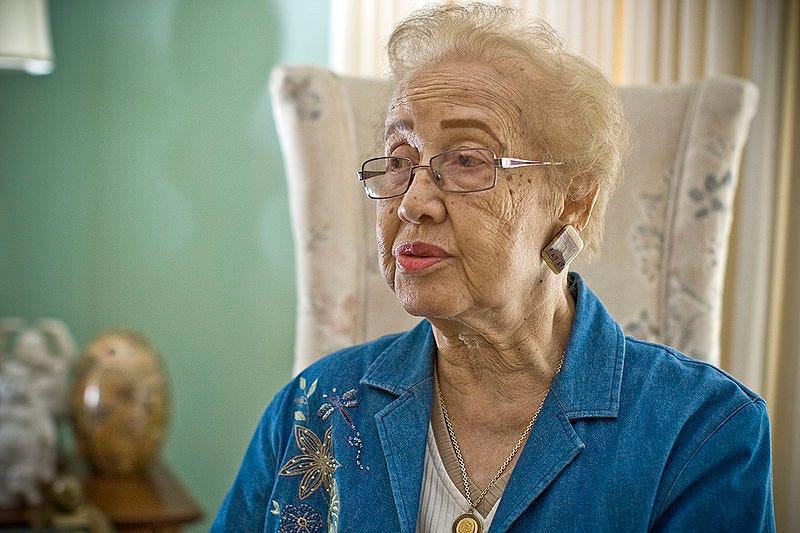
Photo: NASA/Sean Smith
In 1961, Alan Shephard became the first American in space (he’s also famous for hitting a golf ball on the moon) and Katherine calculated the trajectories to get him up there and safely back to Earth. Launches are complicated enough, taking into account things like weather conditions, but soon NASA had her working with orbits too. The following year, John Glenn was to become the first American to orbit the planet and again Katherine was behind the trajectories. For that mission NASA had started using computers for the first time but Katherine’s own calculations were still used to verify that the computers were accurate. The move to computers led to Katherine becoming a computer scientist as well as mathematician.
Katherine was a technical leader during the Apollo missions and played a pivotal role in America’s successful space race. Perhaps her greatest contribution was calculating the trajectories for Apollo 11, the mission that landed humans on the moon for the first time.
“I felt most proud of the success of the Apollo mission. They were going to the moon and I computed the path to get there.”
Later life
Katherine worked on space shuttle and satellite missions before finally retiring in 1986 after 33 years with NASA. During her career she was instrumental in many firsts including the moon landing but also contributed to NASA in more subtle ways. She created space textbooks for the agency; she created star maps that would allow astronauts to pilot themselves home in the event of electronics failures; she co-authored 26 scientific publications; she even contributed work for future missions to Mars.
In retirement, Katherine has been an incredible inspiration to young people and not just because of her past achievements. She has spent decades working with young people to encourage them to take up STEM careers. Over the years her efforts in the space race and in encouraging young people to take up STEM subjects has won her many awards and honorary degrees from universities. Last November, at the age of 97, President Obama awarded Katherine with America’s highest civilian honour: the Presidential Medal of Freedom.
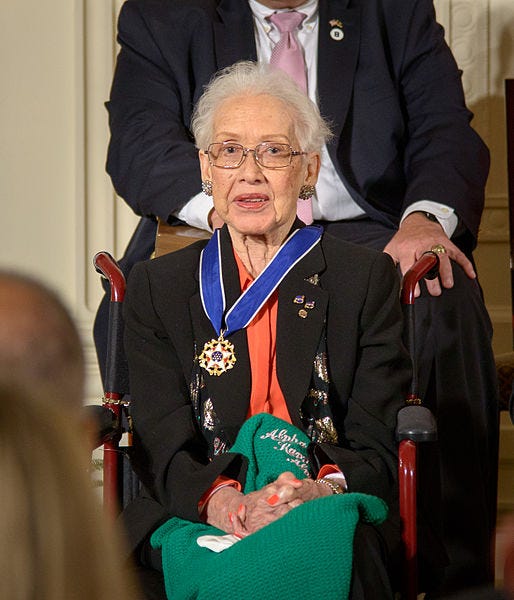
Photo: NASA
Katherine is an inspiration to anyone with a passion. There were many forces in her life that made it difficult to pursue her passion but she overcame them all, including gender discrimination and racial segregation. She didn’t just keep her head down and do the work society expected her to; she wanted to work in a male-dominated field during a time of racial segregation in the US. Katherine believed that she was as good as anyone, “but no better.” Those who worked with her claim she was definitely better. NASA owes Katherine Johnson so much and she will always be a key figure in the history of space exploration.
This is the fourth article in a series about amazing women in tech history. The first featured Margaret Hamilton, the programming pioneer who helped land us on the moon. The second featured Grace Hopper, the programming pioneer who became the first woman to be a US Navy Admiral. The third featured the ENIAC programmers who were pioneers ignored by history. The next is about the women of Bletchley Park, who saved countless lives in WWII but were sworn to secrecy.
Women in tech history: ENIAC and the programming pioneers that nobody knew
This is the third article in a series about amazing women in tech history. The first featured Margaret Hamilton, the programming pioneer who helped land us on the moon. The second featured Grace Hopper, the programming pioneer who became the first woman to be a US Navy Admiral.
In 1946, after World War II had ended, the US Army finally unveiled a top secret project to the public: ENIAC, the first general purpose, all-electronic computer. It was a game-changer. The press called it the “Giant Brain” and dreamed up fantastical futures where we all could have electronic computers in our lives. The designers, John Mauchly and John Presper Eckert, were celebrated for their achievement and rightly so; it was a marvel of engineering. It was designed to calculate ballistics for artillery but was also involved in calculations for the first hydrogen bombs.
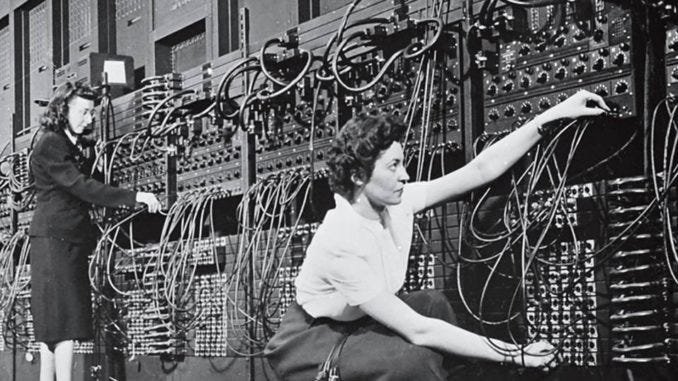
Photo: University of Pennsylvania
In the 1980s, 40 years after the top secret computer was made public, a programmer named Kathy Kleiman asked a fascinating question: who are the women in nearly every photo of the ENIAC computer? They look busy. They’re changing cables and turning switches. What was their involvement in the project? The photos were taken at the public unveiling but the women there weren’t actually introduced. The world had no idea who they were, which is a shame because they were the first programmers of the all-electronic computer.
Ballistics
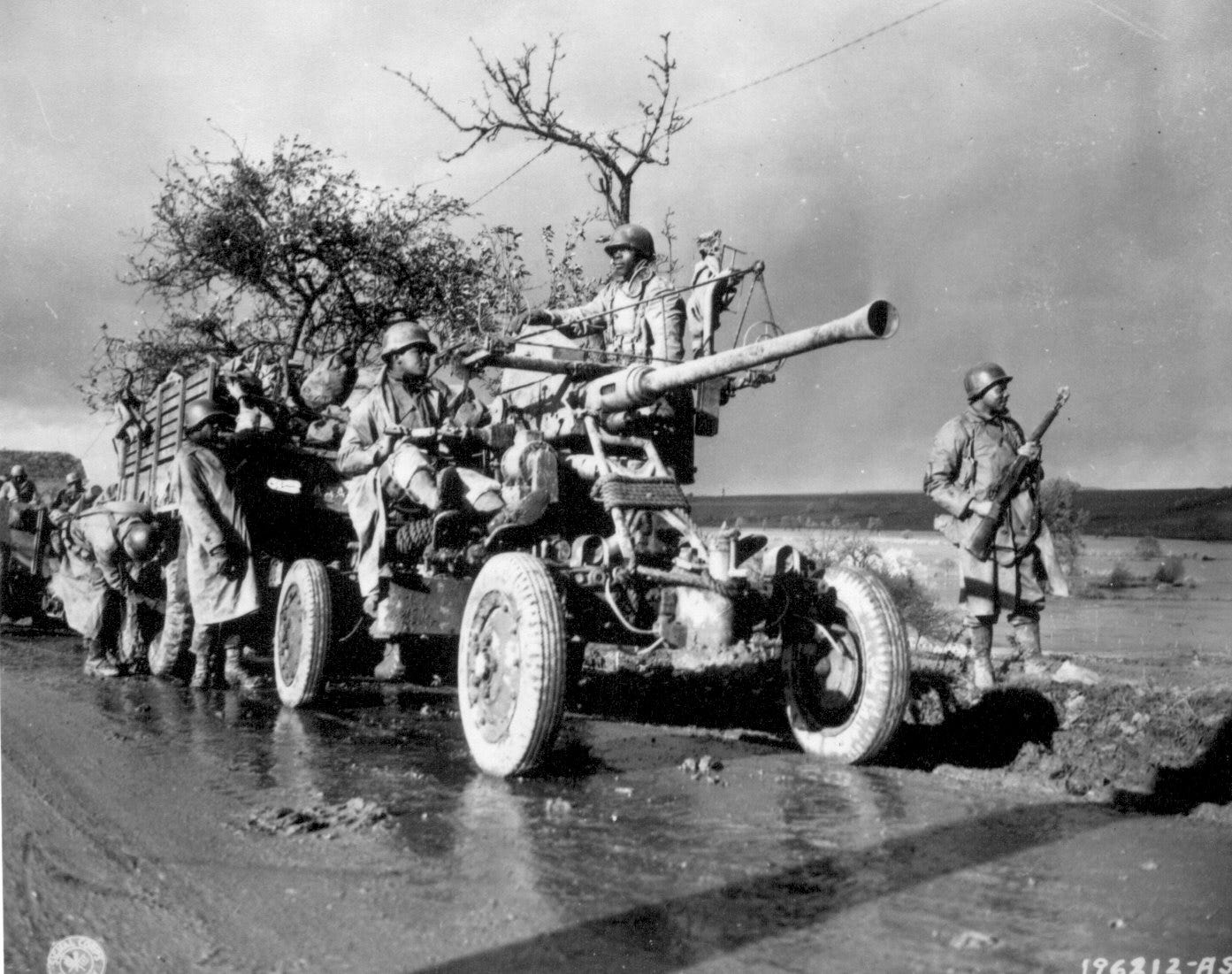
During World War II, long range canons struggled to hit targets that were miles away because the weather affected the trajectory of the missile fired. Using complex equations, which could be modified for different environmental conditions, the accuracy of weapons could be improved. Gunners would look at “firing tables”, which told them where to aim to get the range they were looking for given a specific condition.
The horrifically complex equations were a nightmare. For every possible range of every weapon, they needed to calculate different angles that took everything else into account including temperature and humidity. The equations were so difficult that it took experts days to calculate a single trajectory. This clearly wasn’t something that gunners could calculate on the spot. Instead, the firing tables would need to be calculated by huge teams in order to keep up with the demand.
The problem was that most men with mathematics degrees were fighting overseas or involved in other areas of research such as Project Manhattan. In 1942, the US Army decided to turn to women and put out ads in newspapers looking for maths graduates to work on these calculations at the University of Pennsylvania.
Human “computors”
Betty Holberton was a keen student with a passion for mathematics when she arrived at the University of Pennsylvania to begin a maths degree. On the very first day, her maths professor suggested that her time would be better spent at home raising children. She decided to study journalism instead, since it would allow her to travel, but soon came back to maths when she was hired by the university’s Moore School of Engineering as a “computor”: literally a person that does computations.
Over 100 women were brought in to do the computations necessary for long range weapons to be fired effectively in the war. They each worked with just a pen, paper, and a calculator. It took around 40 hours to do a single trajectory; some of the more difficult ones took a week. The women worked well but simply couldn’t keep up with the machinery of war. The Army needed firing tables faster than the women could calculate them and some guns sat unused. Human computers were too slow.
ENIAC
Funded by the US Army and built by Moore’s School of Engineering, a top-secret computer was built codenamed “Project PX” but would later come to be called ENIAC (Electronic Numerical Integrator And Computer). It was an experimental long shot but it was hoped that the first general purpose, all-electronic computer could drastically improve the speed of trajectory calculations for the firing tables.
The women working on the calculations by hand had no idea about the project. The computer cost $500,000 at a time when the women were making $2000 a year. It worked, it was an engineering marvel, but it couldn’t do anything useful by itself. It was all hardware back then and had to be told what to do. It might be hard to imagine how primitive this computer was but realise that we’re not even talking about punching holes into cards here. Making the computer do something involved using 3,000 switches, 18,000 vacuum tubes, and hundreds of cables. It was 100 ft long and stood 8 ft tall. Different units could do different functions and store a 10-digit number to be passed to the next unit. It seems very alien compared to what we have today.
What ENIAC needed were programmers. They needed to be maths experts who knew the trajectory calculations but they also needed to know how to program the ENIAC. Unfortunately, nobody really knew how to program it. Whoever started would be the first. Of the 100 or so women currently “computing” by hand, 6 were chosen to work on ENIAC. They were Jean Bartik, Kathleen Antonelli, Marlyn Meltzer, Frances Spense, Ruth Teitelbaum, and Betty Holberton who had been told to stay at home to raise children.
Programmers
The challenge that the ENIAC women faced cannot be overstated. Absurdly, they weren’t allowed to see the computer since it was still top secret. Instead, they were given the circuit diagrams and blueprints for the machine and told to teach themselves how it worked. They had to figure out how to program the first general purpose electronic computer purely by studying the inner workings of the machine. Think about how challenging this would have been the next time you struggle with IKEA instructions.
“They had no books or anything to teach us how to program it.” — Jean Bartik

Photo: University of Pennsylvania
Our modern computers do the hard work and we just tell them what to do. Modern computers didn’t appear overnight but gradually evolved so there was a transition between people doing all the computations and computers doing them. The ENIAC was an intermediate, almost like a biological computer with the women as components in the system. The ENIAC couldn’t store software. Instead, the women and the computer worked together as one. The women did the calculations, determined how to have the ENIAC compute the given problems, and then programmed the 1000 kg machine by moving cables around and turning the 3000 different dials. The women said it was difficult, that it was a nightmare at times, and that they loved every moment of it.
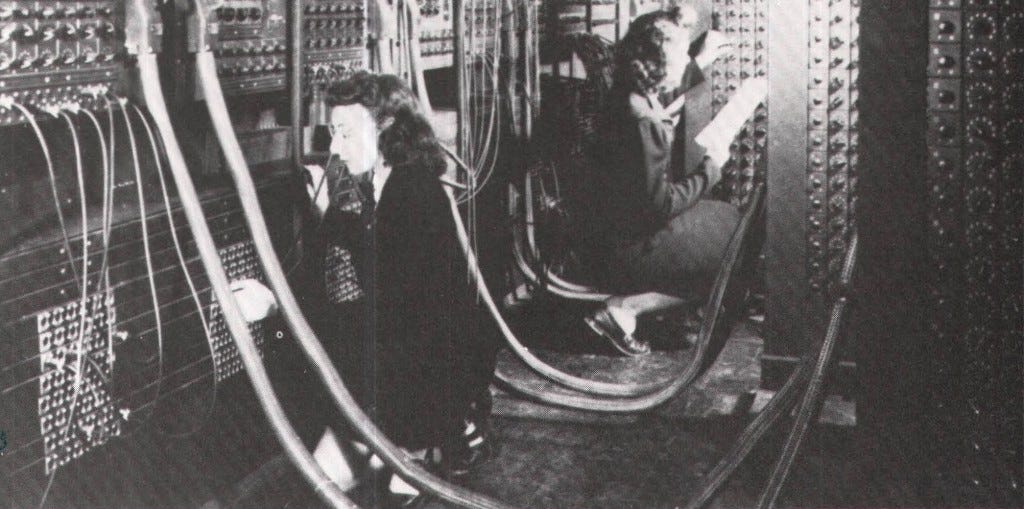
Photo: University of Pennsylvania
They did it. The programmers got the computer calculating a month’s worth of trajectories in a day. They even performed calculations for the feasibility of thermonuclear bombs. Eventually the war was over but it wasn’t the end for the ENIAC. It was developed further to become a “stored program” computer, more closely resembling the modern computers we use today. Jean Bartik led the team that developed the new capabilities.
Going public
In 1946, the US Army dropped the project’s top secret classification and unveiled the ENIAC to the public. It was a big deal and several events were held including a press event where most of the photos we see today were taken. The women were there because the press were given a working demonstration to show how quickly it made advanced calculations. People were truly amazed and the “Giant Brain” made front page headlines of several newspapers.
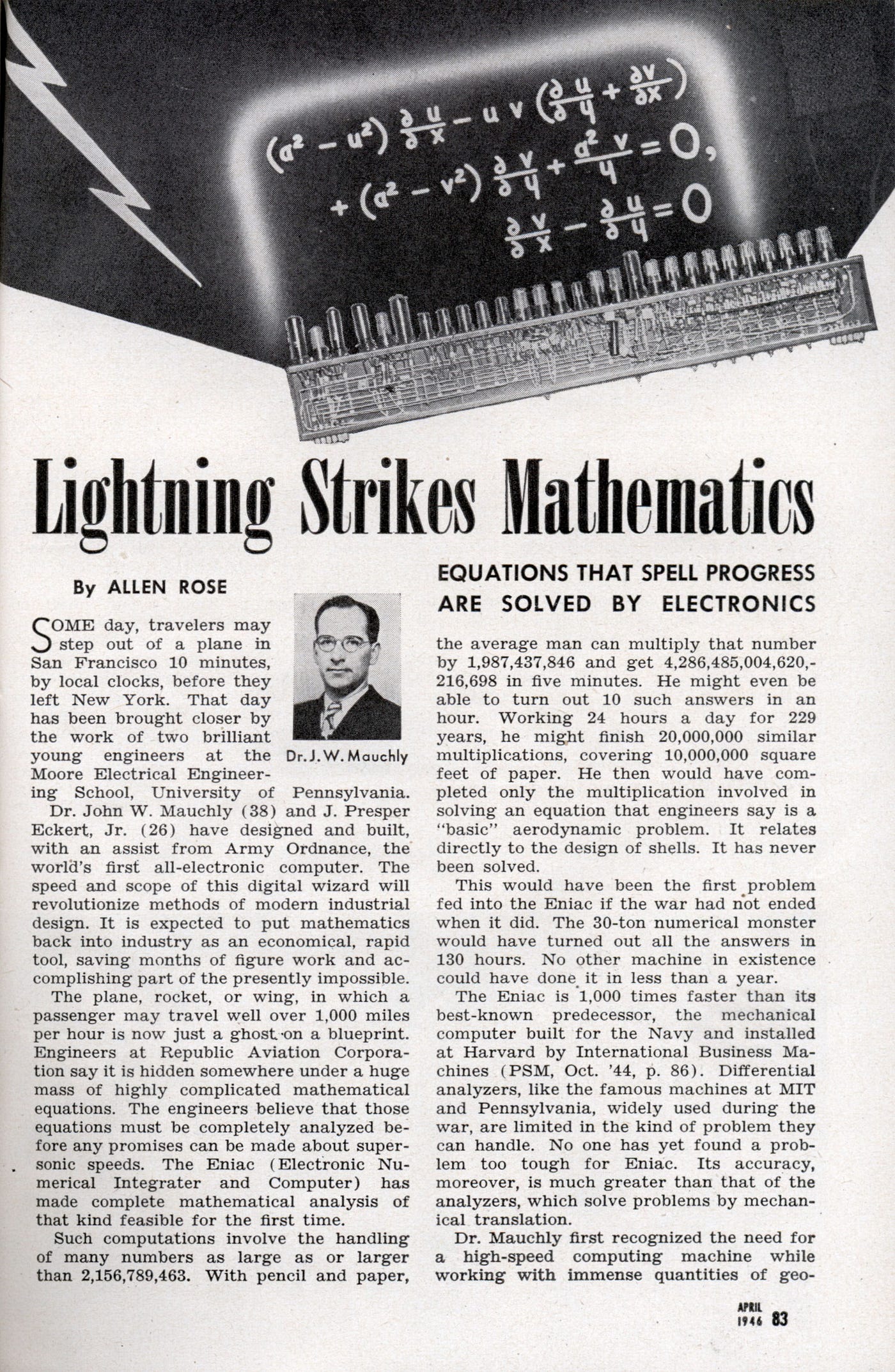
The ENIAC women had two roles: to demonstrate the machine in action and to pose for photos. They became models for the day. “I wasn’t photogenic and I wasn’t included in any of the pictures of the entire stupid thing,” said Betty Holberton. The others were asked to pose for photos, which was fun and it was good to be receiving some recognition for their work. Unfortunately, they weren’t introduced to the press. Their names weren’t recorded and their work wasn’t stated. The designers were celebrated but not the programmers.
After that press event there was another for the science and military community. According to Holberton, the ENIAC women once again weren’t introduced or celebrated. “None of us were introduced; we were just the programmers.” Everyone, including the scientists and military officials, went for dinner but the women weren’t invited. They were the first programmers of a general purpose, all-electronic computer and nobody knew their names.
Recognition
The ENIAC women had great careers and lived fascinating lives. Take Betty Holberton for example: she should have been at home raising children but instead created the first instruction code, invented the first sort routine (yes, when you sort things into order on your computer), and created the first software package. By 1959 she was the Chief of the Programming Research Branch in the Applied Mathematics Laboratory at the David Taylor Model Basin. She even went on to work with Grace Hopper on the COBOL programming language and invented the numeric keyboard (thank you).
Despite their achievements, the ENIAC women were largely unknown for 40 years. It wasn’t just that the general public didn’t know them; tech historians didn’t know they existed. It wasn’t until the 1980s when they were rediscovered by programmers and historians such as Kathy Kleiman. In 1997, after all those years without recognition, the ENIAC women were inducted into the Women in Technology International Hall of Fame.
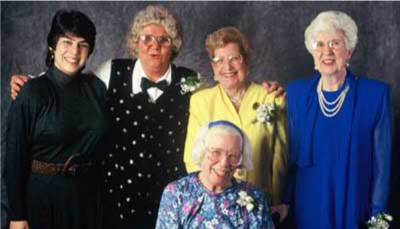
Kathy Kleiman, who rediscovered the ENIAC programmers, standing to the left of Jean Bartik, Marlyn Meltzer and Kay Antonelli. Betty Holberton is in front. Photo: ENIAC Programmers Project
They made strides for women in their later years, working to promote computing to young women and inspiring them with their stories. Imagine being told you can’t do maths and then working on thermonuclear bombs? Imagine being told your education will be a waste of time but end up creating the first user-friendly programming languages?
Their stories show how women can be tech pioneers but they also highlight the sexism that exists in the industry. The ENIAC women should be role models for programmers or anyone who wants to push boundaries and develop next generation technologies. And if you’re thinking about creating a tech startup, look no further than the ENIAC women for inspiration:
“I was told I’d never make VP rank because I was too outspoken. Maybe so, but I think men will always find an excuse for keeping women in their ‘place’. So, let’s make that place the executive suite and start more of our own companies.” — Jean Bartik
You can learn more about the ENIAC programmers at the website for the ENIAC Programmers Project.
This is the third article in a series about amazing women in tech history. The first featured Margaret Hamilton, the programming pioneer who helped land us on the moon. The second featured Grace Hopper, the programming pioneer who became the first woman to be a US Navy Admiral. The next is about Katherine Johnson, who calculated the trajectories that landed humans on the moon.
Women in tech history: Grace Hopper — Admiral, programmer, and rebel
This is the second article in a series about amazing women in tech history. The first featured Margaret Hamilton, the programming pioneer who helped land us on the moon.
The people who change the world are often the rebels; the people who see the world differently and try to push for a new future rather than staying in the past. Grace Hopper was one of those people and she most definitely left her mark on the world. Her life is a story of firsts and she was a pioneer in computer programming from the 1930s right through to the 1980s. That alone is enough of a reason to celebrate her as a woman in tech history but she was so much more. She was the Admiral, the pirate, the trouble-maker, and she was “Amazing Grace”.
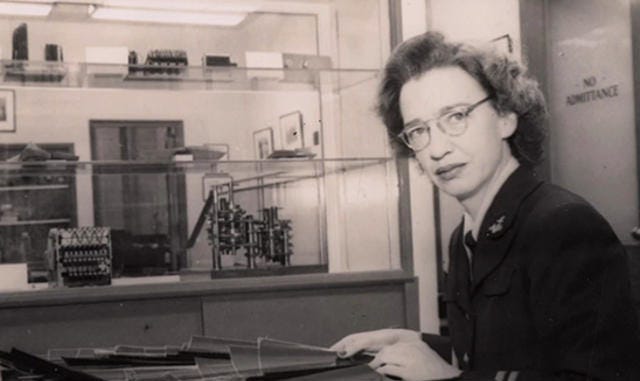
Tinkering toddler
Grace Hopper was born in 1906 in New York to parents of Scottish and Dutch heritage. Her father was a successful businessman and her mother was a housewife with a keen interest in maths. Grace was an exceptionally inquisitive child and played with anything that allowed her to build and disassemble, including construction kits meant for children much older than her. At the age of 7, she wanted to know how alarm clocks worked so she took apart 7 clocks before her mother realised what was going on. Her parents encouraged her natural curiosity and it was no surprise when she went on to study maths at university.
Grace obtained a bachelor’s degree in maths and physics at Vassar College before graduating with a master’s in maths from Yale in 1930. By 1934 she was the first woman to ever complete a maths PhD at Yale. Being first is a recurring theme in her life. Throughout the 1930s she taught maths and was an associate professor in 1941. At this time, the US was in the grip of World War II. The attack on Pearl Harbor was a turning point for Grace. She could have become a full professor at Vassar but she had somewhere else to be. In 1943 she chose to serve her country by volunteering for the Navy.
Bugs at Harvard
Grace volunteered for the women’s reserve in the Navy but almost didn’t get accepted as she was tiny, weighing 15 pounds less than the minimum weight. Fortunately she was exempted and graduated first from her training class, proving that they had made the right decision. She was made lieutenant and joined the Bureau of Ships Computation Project at Harvard University, where she quickly made her mark as a programmer on the Harvard Mark I computer. You’ve probably heard the story about a bug being found in an early computer; literally a moth. That was the Harvard Mark II and Grace popularised the terms “bug” and “debugging” as they’re used in computing.
“From then on, when anything went wrong with a computer, we said it had bugs in it.”
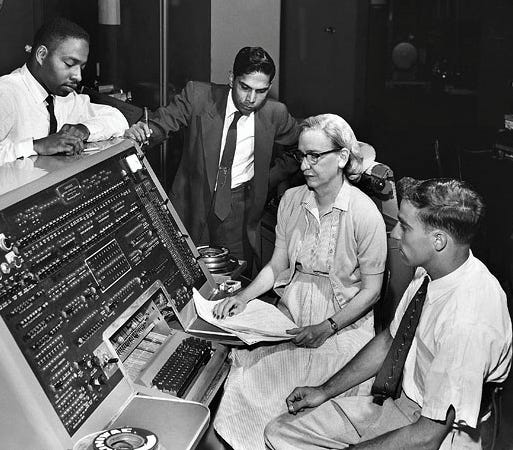
At Harvard she created one of her first important inventions: the subroutine, a single unit of program tasks that can be called upon and used repeatedly. Continuing to work on Navy projects, Grace joined the Eckert–Mauchly Computer Corporation in 1949 to work on the UNIVAC I computer. It was at this time that she made one of her greatest contributions to computing by inventing the compiler, a program that takes instructions written in a programming language and translates them into another language or the machine code that a processor can understand.
Compilers are a fundamental aspect of modern programming so it can’t be overstated how important this contribution is. At the time nobody could believe it had been done. It was considered a fruitless effort and that her time would be better spent working on other problems. That’s exactly the kind of response that would inspire Grace to press on anyway.
“Nobody believed it. I had a running compiler and nobody would touch it. They carefully told me, computers only do arithmetic; they could not do programs.”
Programming in English
The development of the compiler led Grace down a road that changed programming languages as we know them. She had a strong belief that programming didn’t have to be done in machine code and that more programming languages using plain English could make the field more accessible for everyone. She had created a programming language for the UNIVAC computers called FLOW-MATIC that used plain English and relied on her compiler to translate the language into something the computers could understand.
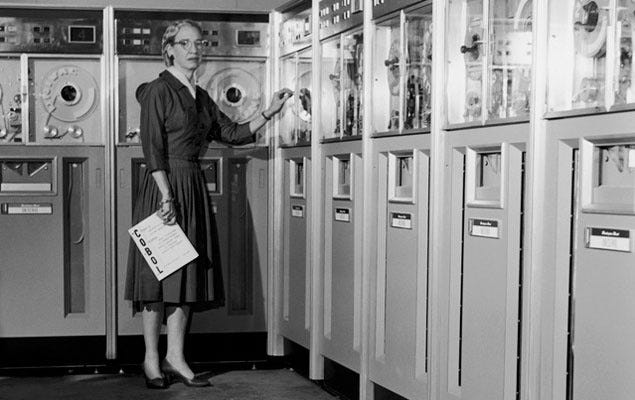
In 1959, she led a team of experts who modified her FLOW-MATIC language to create COBOL (Common Business-Oriented Language). It became the most common programming language for businesses and the US military due to its use of plain English and despite being 57 years old it’s still found in many business systems today. Modern languages are better, of course, so most of the current users are simply keeping older systems up and running. But it’s a testament to the the quality and vision of the project that it had such a lasting effect.
The Admiral
The Navy meant as much to Grace as programming and mathematics did. In 1966 she held the title of Commander but was forced to retire because she had reached the age of 60, which was standard practice. A year later they asked her back to work for just 6 months. Instead, she continued to serve for another 4 years before retiring again. History repeated itself and a year later she was asked back.
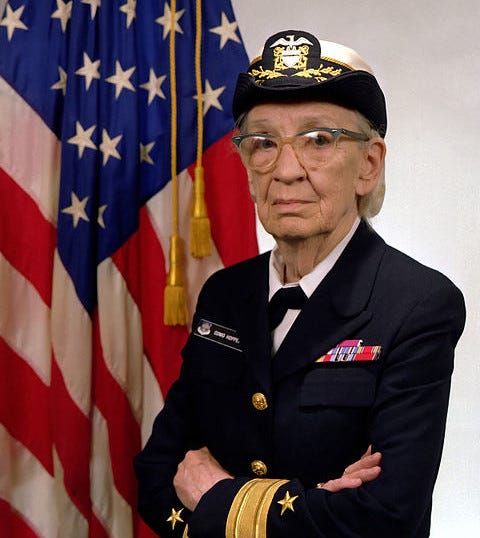
When she finally retired from the Navy for good, she was almost 80 years old, the oldest person actively serving, and the first woman to reach the rank of Admiral. Her retirement was celebrated on the USS Constitution and she received the highest decoration the Department of Defense can award for a non-combat role: the Defense Distinguished Service Medal. She worked as a consultant for another 5 years until her death.
Grace had a rebellious nature; this wasn’t because she enjoyed getting into trouble but because she wanted to change things when people told her it couldn’t be done. Biographer Jay Elliot wrote that she appeared all Navy, but inside there was “a pirate dying to be released.” Her rebellious nature is what helped her get things done. She wasn’t one to hide this aspect of her personality:
“Humans are allergic to change. They love to say, ‘we’ve always done it this way.’ I try to fight that. That’s why I have a clock on my wall that runs counter-clockwise.”
It’s obvious how respected she is in computing and in the Navy. She has a supercomputer and even an aircraft carrier named after her. Every year there’s a conference in her name that celebrates women in computing. She received over 40 honorary degrees from universities. Obviously her story is an inspiration to many. Not every programmer wants to work in the Navy; not everyone wants to write their own programming language; but she was an inspiration, not just for her achievements, but also her attitude:
The most important thing I’ve accomplished, other than building the compiler, is training young people. They come to me, you know, and say, ‘Do you think we can do this?’ I say, “Try it.” And I back ’em up. They need that. I keep track of them as they get older and I stir ’em up at intervals so they don’t forget to take chances.
Try it. Take chances. When others do, back ’em up.
This is the second article in a series about amazing women in tech history. The first was about Margaret Hamilton, the pioneering programmer who helped land us on the moon. The next is about the ENIAC women who were written out of history.